Analysis of Hotspots and Trends in Soil Moisture Research since the 21st Century
Abstract
:1. Introduction
2. Materials and Methods
2.1. Data Sources and Pre-Processing
2.2. Data Processing Methods
3. Results
3.1. Publication and Cooperation Networks
3.1.1. Quantitative Evolution Trend of Article Publications
3.1.2. International Collaborations
3.1.3. Institutional Collaborations
3.2. Mainstream Journals
3.3. Hot Topics and Frontiers
4. Discussion
5. Conclusions
Author Contributions
Funding
Institutional Review Board Statement
Informed Consent Statement
Data Availability Statement
Conflicts of Interest
References
- Seneviratne, S.I.; Corti, T.; Davin, E.L.; Hirschi, M.; Jaeger, E.B.; Lehner, I.; Orlowsky, B.; Teuling, A.J. Investigating soil moisture-Climate interactions in a changing climate: A review. Earth-Sci. Rev. 2010, 99, 125–161. [Google Scholar] [CrossRef]
- Štekauerová, V.; Nagy, V.; Kotorová, D. Soil water regime of agricultural field and forest ecosystems. Biologia 2006, 61, 300–304. [Google Scholar] [CrossRef]
- Bell, J.M.; Schwartz, R.C.; McInnes, K.J.; Howell, T.A.; Morgan, C.L.S. Effects of irrigation level and timing on profile soil water use by grain sorghum. Agric. Water Manag. 2020, 232, 106030. [Google Scholar] [CrossRef]
- Robock, A.; Vinnikov, K.Y.; Srinivasan, G.; Entin, J.K.; Hollinger, S.E.; Speranskaya, N.A.; Liu, S.; Namkhai, A. The Global Soil Moisture Data Bank. Bull. Am. Meteorol. Soc. 2000, 81, 1281–1299. [Google Scholar] [CrossRef]
- Chen, H.; Qin, A.; Chai, Q.; Gan, Y.; Liu, Z. Quantification of Soil Water Competition and Compensation Using Soil Water Differences between Strips of Intercropping. Agric. Res. 2014, 3, 321–330. [Google Scholar] [CrossRef]
- Bodner, G.; Nakhforoosh, A.; Kaul, H. Management of crop water under drought: A review. Agron. Sustain. Dev. 2015, 35, 401–442. [Google Scholar] [CrossRef]
- Sawatsky, N.; Li, X. Importance of soil-water relations in assessing the endpoint of bioremediated soils. Plant Soil 1997, 192, 227–236. [Google Scholar] [CrossRef]
- Rawls, W.J.; Pachepsky, Y.A.; Ritchie, J.C.; Sobecki, T.M.; Bloodworth, H.; Ahuja, L.R. Effect of soil organic carbon on soil water retention. Geoderma 2003, 116, 61–76. [Google Scholar] [CrossRef]
- Li, S.; Zhou, D.; Luan, Z.; Pan, Y.; Jiao, C. Quantitative simulation on soil moisture contents of two typical vegetation communities in Sanjiang Plain, China. Chin. Geogr. Sci. 2011, 21, 723–733. [Google Scholar] [CrossRef]
- Wood, E.F. Global Scale Hydrology: Advances in Land Surface Modeling; Shea, M.A., Ed.; American Geophysical Union: Washington, DC, USA, 1991; Volume 29, pp. 193–201. [Google Scholar]
- Mehrotra, R. Sensitivity of runoff, soil moisture and reservoir design to climate change in central Indian River basins. Clim. Chang. 1999, 42, 725–757. [Google Scholar] [CrossRef]
- Ying, Z.; Bingcheng, S.; Hailong, H.; Jinghui, X.; Stephan, P.; Rainer, H. Modeling of Coupled Water and Heat Transfer in Freezing and Thawing Soils, Inner Mongolia. Water 2016, 8, 424. [Google Scholar]
- Bogoslovskiy, N.N.; Erin, S.I.; Borodina, I.A.; Kizhner, L.I. Filtration and assimilation of soil moisture satellite data. In Proceedings of the 21st International Symposium on Atmospheric and Ocean Optics: Atmospheric Physics, Tomsk, Russia, 22–26 June 2015; Volume 9680, pp. 1411–1415. [Google Scholar]
- Liu, Y.; Yang, Y. Advances in the Quality of Global Soil Moisture Products: A Review. Remote Sens. 2022, 14, 3741. [Google Scholar] [CrossRef]
- Van Hateren, T.C.; Chini, M.; Matgen, P.; Teuling, A.J. Ambiguous Agricultural Drought: Characterising Soil Moisture and Vegetation Droughts in Europe from Earth Observation. Remote Sens. 2021, 13, 1990. [Google Scholar] [CrossRef]
- Ramat, G.; Santi, E.; Paloscia, S.; Fontanelli, G.; Pettinato, S.; Santurri, L.; Souissi, N.; Ponte, E.D.; Wahab, M.M.A.; Khalil, A.A.; et al. Remote sensing techniques for water management and climate change monitoring in drought areas: Case studies in Egypt and Tunisia. Eur. J. Remote Sens. 2023, 56, 23. [Google Scholar] [CrossRef]
- McColl, K.A.; Alemohammad, S.H.; Akbar, R.; Konings, A.G.; Yueh, S.; Entekhabi, D. The global distribution and dynamics of surface soil moisture. Nat. Geosci. 2017, 10, 100–104. [Google Scholar] [CrossRef]
- Cui, Y.; Zeng, C.; Zhou, J.; Xie, H.; Wan, W.; Hu, L.; Xiong, W.; Chen, X.; Fan, W.; Hong, Y. A spatio-temporal continuous soil moisture dataset over the Tibet Plateau from 2002 to 2015. Sci. Data 2019, 6, 247. [Google Scholar] [CrossRef]
- Ellegaard, O.; Wallin, J.A. The bibliometric analysis of scholarly production: How great is the impact? Scientometrics 2015, 105, 1809–1831. [Google Scholar] [CrossRef]
- Godin, B. On the origins of bibliometrics. Scientometrics 2006, 68, 25. [Google Scholar] [CrossRef]
- Yan, J.; Wang, C.; Cheng, W.; Gao, M.; Zhou, A. Aretro spective of knowledge graphs. Front. Comput. Sci. 2018, 12, 20. [Google Scholar] [CrossRef]
- Guil-Guerrero, J.L.; Manzano-Agugliaro, F. Worldwide research trends on Neanderthals. J. Quat. Sci. 2023, 38, 208–220. [Google Scholar] [CrossRef]
- Burhanudin, K.; Jusoh, M.H.; Latiff, Z.I.A.; Hashim, M.H.; Ashar, N.D.K. The Estimation of the Geomagnetically Induced Current Based on Simulation and Measurement at the Power Network: A Bibliometric Analysis of 42 Years (1979–2021). IEEE Access 2022, 10, 56525–56549. [Google Scholar] [CrossRef]
- Sanchez-Nunez, P.; Cobo, M.J.; De Las Heras-Pedrosa, C.; Pelaez, J.I.; Herrera-Viedma, E. Opinion Mining, Sentiment Analysis and Emotion Understanding in Advertising: A Bibliometric Analysis. IEEE Access 2020, 8, 134563–134576. [Google Scholar] [CrossRef]
- Blanco-Mesa, F.; Leon-Castro, E.; Merigo, J.M. A bibliometric analysis of aggregation operators. Appl. Soft Comput. 2019, 81, 105488. [Google Scholar] [CrossRef]
- Chen, X.; Jia, S.; Xiang, Y. Areview: Knowledge reasoning over knowledge graph. Expert Syst. Appl. 2020, 141, 21. [Google Scholar] [CrossRef]
- Aria, M.; Cuccurullo, C. bibliometrix: An R-tool for comprehensive science mapping analysis. J. Informetr. 2017, 11, 959–975. [Google Scholar] [CrossRef]
- Xu, Y.; Yang, Y.; Chen, X.; Liu, Y. Bibliometric Analysis of Global NDVI Research Trends from 1985 to 2021. Remote Sens. 2022, 14, 3967. [Google Scholar] [CrossRef]
- Tang, L.; Cao, C.; Wang, Z.; Zhou, Z. Decoupling in science and education: A collateral damage beyond deteriorating US–China relations. Sci. Public Policy 2021, 48, 630–634. [Google Scholar] [CrossRef]
- Zhu, J.; Liu, W. Comparing like with like: China ranks first in SCI-indexed research articles since 2018. Scientometrics 2020, 124, 1691–1700. [Google Scholar] [CrossRef]
- Feddes, R.A.; Kowalik, P.; Kolinska-Malinka, K.; Zaradny, H. Simulation of field water uptake by plants using a soil water dependent root extraction function. J. Hydrol. 1976, 31, 13–26. [Google Scholar] [CrossRef]
- Wang, M.; Chai, L. Three new bibliometric indicators/approaches derived from keyword analysis. Scientometrics 2018, 116, 30. [Google Scholar] [CrossRef]
- Green, J.K.; Seneviratne, S.I.; Berg, A.M.; Findell, K.L.; Hagemann, S.; Lawrence, D.M.; Gentine, P. Large influence of soil moisture on long-term terrestrial carbon uptake. Nature 2019, 565, 476–479. [Google Scholar] [CrossRef] [PubMed]
- Guo, Y.; Peng, C.; Zhu, Q.; Wang, M.; Wang, H.; Peng, S.; He, H. Modelling the impacts of climate and land use changes on soil water erosion: Model applications, limitations and future challenges. J. Environ. Manag. 2019, 250, 109403. [Google Scholar] [CrossRef] [PubMed]
- Cheema, M.J.M.; Bastiaanssen, W.G.M.; Rutten, M.M. Validation of surface soil moisture from AMSR-E using auxiliary spatial data in the transboundary Indus Basin. J. Hydrol. 2011, 405, 137–149. [Google Scholar] [CrossRef]
- Dong, J.; Akbar, R.; Feldman, A.F.; Gianotti, D.S.; Entekhabi, D. Land Surfaces at the Tipping-Point for Water and Energy Balance Coupling. Water Resour. Res. 2023, 59, e2022WR032472. [Google Scholar] [CrossRef]
- Orduña Alegría, M.E.; Schütze, N.; Niyogi, D. Evaluation of Hydroclimatic Variability and Prospective Irrigation Strategies in the U.S. Corn Belt. Water 2019, 11, 2447. [Google Scholar] [CrossRef]
- Belder, P.; Bouman, B.A.M.; Cabangon, R.; Guoan, L.; Quilang, E.J.P.; Yuanhua, L.; Spiertz, J.H.J.; Tuong, T.P. Effect of water-saving irrigation on rice yield and water use in typical lowland conditions in Asia. Agric. Water Manag. 2004, 65, 193–210. [Google Scholar] [CrossRef]
- Ulrich, D.E.M.; Sevanto, S.; Ryan, M.; Albright, M.B.N.; Johansen, R.B.; Dunbar, J.M. Plant-microbe interactions before drought influence plant physiological responses to subsequent severe drought. Sci. Rep. 2019, 9, 249. [Google Scholar] [CrossRef]
- Chen, J.M.; Chen, X.; Ju, W.; Geng, X. Distributed hydrological model for mapping evapotranspiration using remote sensing inputs. J. Hydrol. 2005, 305, 15–39. [Google Scholar] [CrossRef]
- Hailin, Z.; Xiuyun, L.; Jun, Y.; Xiufeng, Y.; Tieniu, W.; Yi, H.; He, D.; Muxing, L.; Pei, T. Bibliometric Analysis of Research on Soil Water from 1934 to 2019. Water 2020, 12, 1631. [Google Scholar]
- Reichle, R.H. Data assimilation methods in the Earth sciences. Adv. Water Resour. 2008, 31, 1411–1418. [Google Scholar] [CrossRef]
- Karthikeyan, L.; Pan, M.; Wanders, N.; Kumar, D.N.; Wood, E.F. Four decades of microwave satellite soil moisture observations; Part 1, A review of retrieval algorithms. Adv. Water Resour. 2017, 109, 106–120. [Google Scholar] [CrossRef]
- Foody, G.M. Soil moisture content ground data for remote sensing investigations of agricultural regions. Int. J. Remote Sens. 1991, 12, 1461–1469. [Google Scholar] [CrossRef]
- Zhu, Q.; Liao, K.; Xu, Y.; Yang, G.; Wu, S.; Zhou, S. Monitoring and prediction of soil moisture spatial-temporal variations from a hydropedological perspective; a review. Soil Res. 2012, 50, 625–637. [Google Scholar] [CrossRef]
- McGuirk, S.L.; Cairns, I.H. Soil moisture prediction with multispectral visibal and nir remote sensing. ISPRS Ann. Photogramm. Remote Sens. Spat. Inf. Sci. 2022, V-3-2022, 447–453. [Google Scholar] [CrossRef]
- Gebremedhin, G.H.; Qiuhong, T.; Wenhong, L.; Xingcai, L.; Xuejun, Z. Drought: Progress in broadening its understanding. Wiley Interdiscip. Rev. Water 2020, 7, e1407. [Google Scholar]
- Al Bitar, A.; Leroux, D.; Kerr, Y.H.; Merlin, O.; Richaume, P.; Sahoo, A.; Wood, E.F. Evaluation of SMOS Soil Moisture Products Over Continental U.S. Using the SCAN/SNOTEL Network. IEEE Trans. Geosci. Remote Sens. 2012, 50, 1572–1586. [Google Scholar] [CrossRef]
- Chan, S.K.; Bindlish, R.; O’Neill, P.E.; Njoku, E.; Jackson, T.; Colliander, A.; Chen, F.; Burgin, M.; Dunbar, S.; Piepmeier, J.; et al. Assessment of the SMAP Passive Soil Moisture Product. IEEE Trans. Geosci. Remote Sens. 2016, 54, 4994–5007. [Google Scholar] [CrossRef]
- Hoffmann, L.; Gunther, G.; Li, D.; Stein, O.; Wu, X.; Griessbach, S.; Heng, Y.; Konopka, P.; Muller, R.; Vogel, B.; et al. From ERA-Interim to ERA5: The considerable impact of ECMWF’s next-generation reanalysis on Lagrangian transport simulations. Atmos. Chem. Phys. 2019, 19, 3097–3124. [Google Scholar] [CrossRef]
- Wang, H.; Zhao, R.; Zhao, D.; Liu, S.; Fu, J.; Zhang, Y.; Dai, N.; Song, D.; Ding, H. Microbial-Mediated Emissions of Greenhouse Gas from Farmland Soils: A Review. Processes 2022, 10, 2361. [Google Scholar] [CrossRef]
- Deng, C.; Li, R.; Xie, B.; Wan, Y.; Li, Z.; Liu, C. Impacts of the integrated pattern of water and land resources use on agricultural greenhouse gas emissions in China during 2006–2017: A water-land-energy-emissions nexus analysis. J. Clean Prod. 2021, 308, 127221. [Google Scholar] [CrossRef]
- Oertel, C.; Matschullat, J.; Zurba, K.; Zimmermann, F.; Erasmi, S. Greenhouse gas emissions from soils—A review. Geochemistry 2016, 76, 327–352. [Google Scholar] [CrossRef]
- Ji, D.; Zhou, M.; Wang, P.; Yang, Y.; Wang, T.; Sun, X.; Hermans, C.; Yao, B.; Wang, G. Deriving Temporal and Vertical Distributions of Methane in Xianghe Using Ground-based Fourier Transform Infrared and Gas-analyzer Measurements. Adv. Atmos. Sci. 2020, 37, 597–607. [Google Scholar] [CrossRef]
- Thompson, R.L.; Lassaletta, L.; Patra, P.K.; Wilson, C.; Wells, K.C.; Gressent, A.; Koffi, E.N.; Chipperfield, M.P.; Winiwarter, W.; Davidson, E.A.; et al. Acceleration of global N2O emissions seen from two decades of atmospheric inversion. Nat. Clim. Chang. 2019, 9, 993–998. [Google Scholar] [CrossRef]
- Cui, X.; Zhou, F.; Ciais, P.; Davidson, E.A.; Tubiello, F.N.; Niu, X.; Ju, X.; Canadell, J.G.; Bouwman, A.F.; Jackson, R.B.; et al. Global mapping of crop-specific emission factors highlights hotspots of nitrous oxide mitigation. Nat. Food 2021, 2, 886–893. [Google Scholar] [CrossRef] [PubMed]
- Tian, H.; Xu, R.; Canadell, J.G.; Thompson, R.L.; Winiwarter, W.; Suntharalingam, P.; Davidson, E.A.; Ciais, P.; Jackson, R.B.; Janssens-Maenhout, G.; et al. A comprehensive quantification of global nitrous oxide sources and sinks. Nature 2020, 586, 248–256. [Google Scholar] [CrossRef]
- Zhang, B.; Zhou, M.; Lin, H.; Ntacyabukura, T.; Wang, Y.; Zhu, B. Effects of different long-term crop straw management practices on ammonia volatilization from subtropical calcareous agricultural soil. Atmos. Ocean. Sci. Lett. Daqi-He-Haiyang-Kexue-Kuaibao 2020, 13, 232–239. [Google Scholar] [CrossRef]
- Sun, J.; Peng, H.; Chen, J.; Wang, X.; Wei, M.; Li, W.; Yang, L.; Zhang, Q.; Wang, W.; Mellouki, A. An estimation of CO2 emission via agricultural crop residue open field burning in China from 1996 to 2013. J. Clean. Prod. 2016, 112, 2625–2631. [Google Scholar] [CrossRef]
- Sun, D.; Tang, X.; Li, J.; Liu, M.; Hou, L.; Yin, G.; Chen, C.; Zhao, Q.; Klümper, U.; Han, P. Chlorate as a comammox Nitrospira specific inhibitor reveals nitrification and N2O production activity in coastal wetland. Soil Biol. Biochem. 2022, 173, 108782. [Google Scholar] [CrossRef]
- Wang, Q.; Zhao, X.; Chen, L.; Yang, Q.; Chen, S.; Zhang, W. Global synthesis of temperature sensitivity of soil organic carbon decomposition: Latitudinal patterns and mechanisms. Funct. Ecol. 2019, 33, 514–523. [Google Scholar] [CrossRef]
- Kellman, L.L.; Myette, A.A.; Beltrami, H.H. Depth-Dependent Mineral Soil CO2 Production Processes: Sensitivity to Harvesting-Induced Changes in Soil Climate. PLoS ONE 2015, 10, e0134171. [Google Scholar] [CrossRef]
- Voigt, C.; Lamprecht, R.E.; Marushchak, M.E.; Lind, S.E.; Novakovskiy, A.; Aurela, M.; Martikainen, P.J.; Biasi, C. Warming of subarctic tundra increases emissions of all three important greenhouse gases-carbon dioxide, methane, and nitrous oxide. Glob. Chang. Biol. 2017, 23, 3121–3138. [Google Scholar] [CrossRef] [PubMed]
- Derenne, S.; Quénéa, K. Analytical pyrolysis as a tool to probe soil organic matter. J. Anal. Appl. Pyrolysis 2015, 111, 108–120. [Google Scholar] [CrossRef]
- Li, Y.; Dong, S.; Liu, S.; Zhou, H.; Gao, Q.; Cao, G.; Wang, X.; Su, X.; Zhang, Y.; Tang, L.; et al. Seasonal changes of CO2, CH4 and N2O fluxes in different types of alpine grassland in the Qinghai-Tibetan Plateau of China. Soil Biol. Biochem. 2015, 80, 306–314. [Google Scholar] [CrossRef]
- Chen, H.; Yang, Z.; Chu, R.K.; Tolic, N.; Liang, L.; Graham, D.E.; Wullschleger, S.D.; Gu, B. Molecular Insights into Arctic Soil Organic Matter Degradation under Warming. Environ. Sci. Technol. 2018, 52, 4555–4564. [Google Scholar] [CrossRef]
- Mishra, A.K.; Singh, V.P. Drought modeling: A review. J. Hydrol. 2011, 403, 157–175. [Google Scholar] [CrossRef]
- Quiring, S.M. Developing Objective Operational Definitions for Monitoring Drought. J. Appl. Meteorol. Clim. 2009, 48, 1217–1229. [Google Scholar] [CrossRef]
- Yao, Y.; Chen, X.; Qian, J. Advance in Agricultural Drought Monitoring Using Remote Sensing Data. Spectrosc. Spectr. Anal. 2019, 39, 8. [Google Scholar]
- Allan, R.P.; Barlow, M.; Byrne, M.P.; Cherchi, A.; Douville, H.; Fowler, H.J.; Gan, T.Y.; Pendergrass, A.G.; Rosenfeld, D.; Swann, A.L.S.; et al. Advances in understanding large-scale responses of the water cycle to climate change. Ann. N. Y. Acad. Sci. 2020, 1472, 49–75. [Google Scholar] [CrossRef]
- Hatfield, J.L.; Dold, C. Water-Use Efficiency: Advances and Challenges in a Changing Climate. Front. Plant Sci. 2019, 10, 103. [Google Scholar] [CrossRef]
- Blum, A. Effective use of water (EUW) and not water-use efficiency (WUE) is the target of crop yield improvement under drought stress. Field Crops Res. 2009, 112, 119–123. [Google Scholar] [CrossRef]
- Badaluddin, N.A.; Lion, M.; Razali, S.M.; Khalit, S.I. Bibliometric Analysis of Global Trends on Soil Moisture Assessment Using the Remote Sensing Research Study from 2000 to 2020. Water Air Soil Pollut. 2021, 232, 271. [Google Scholar] [CrossRef]
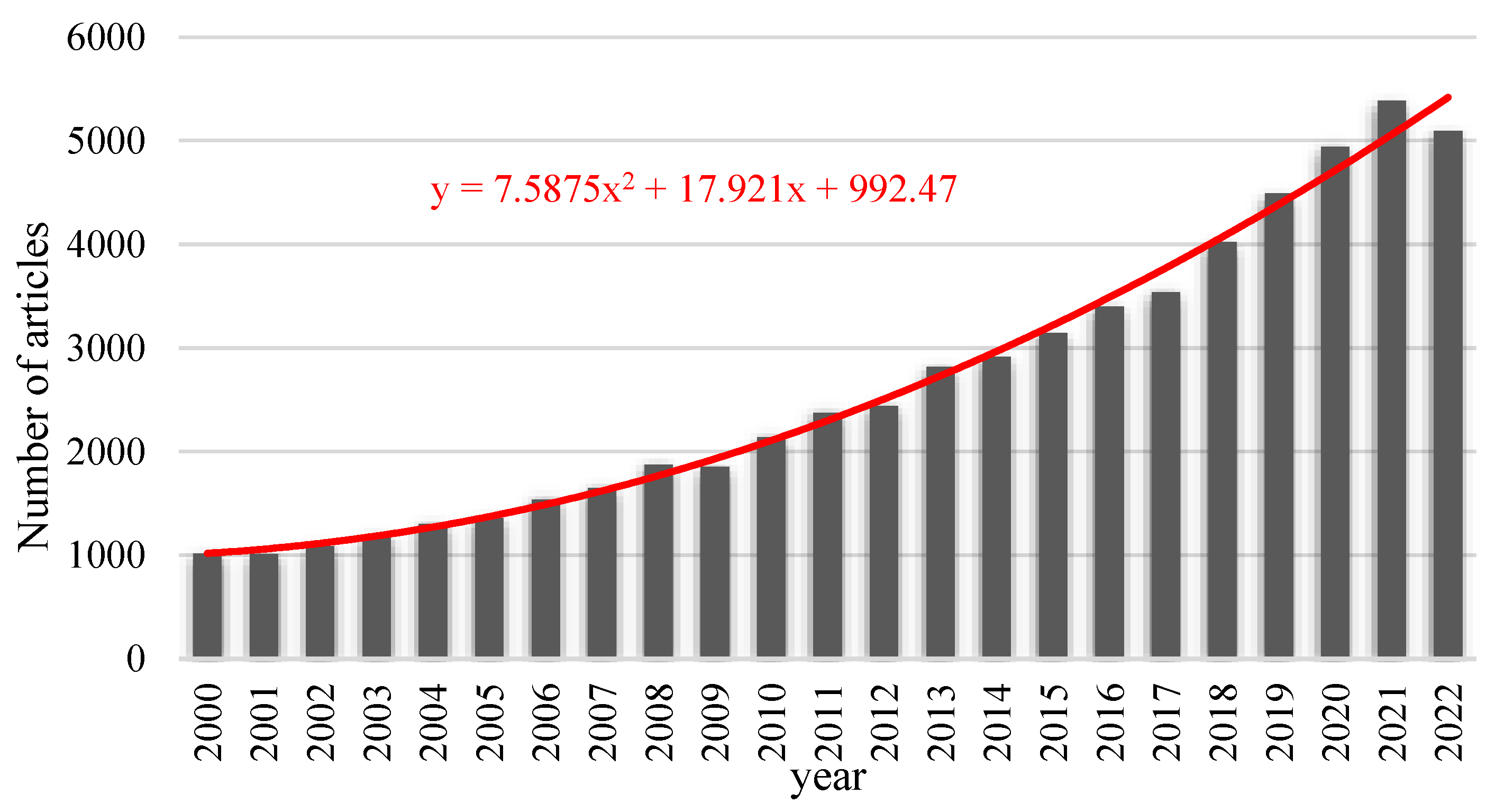
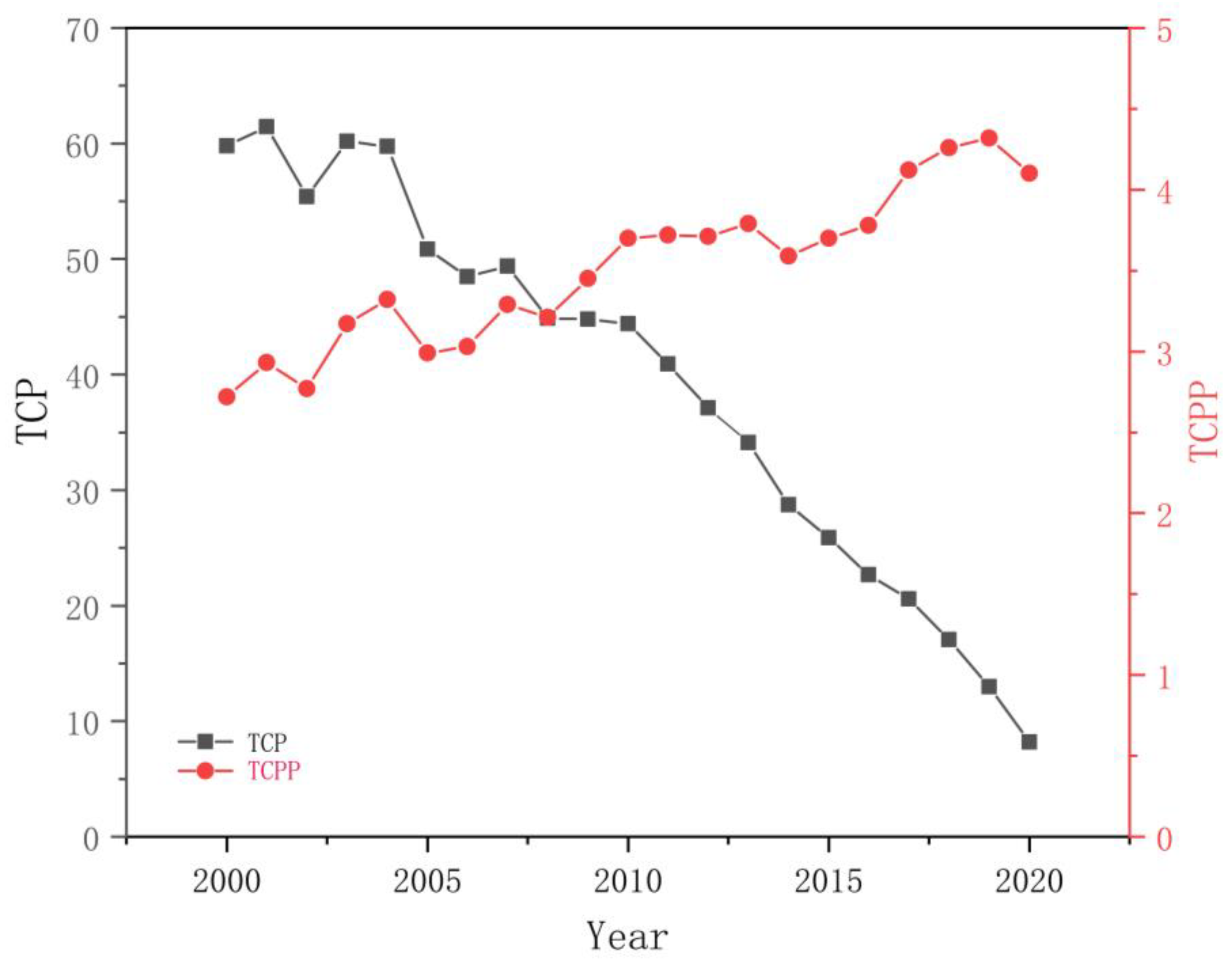
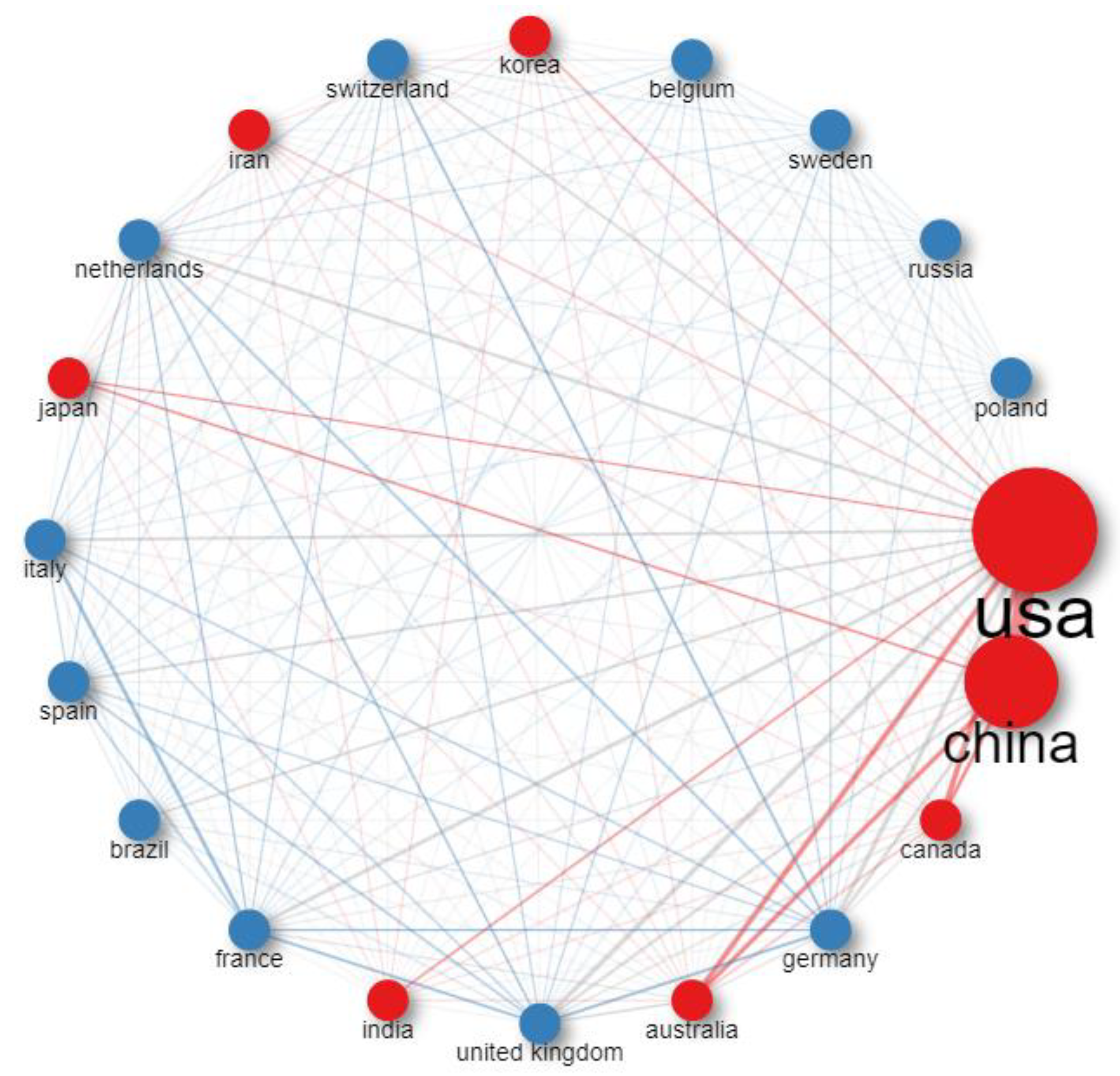
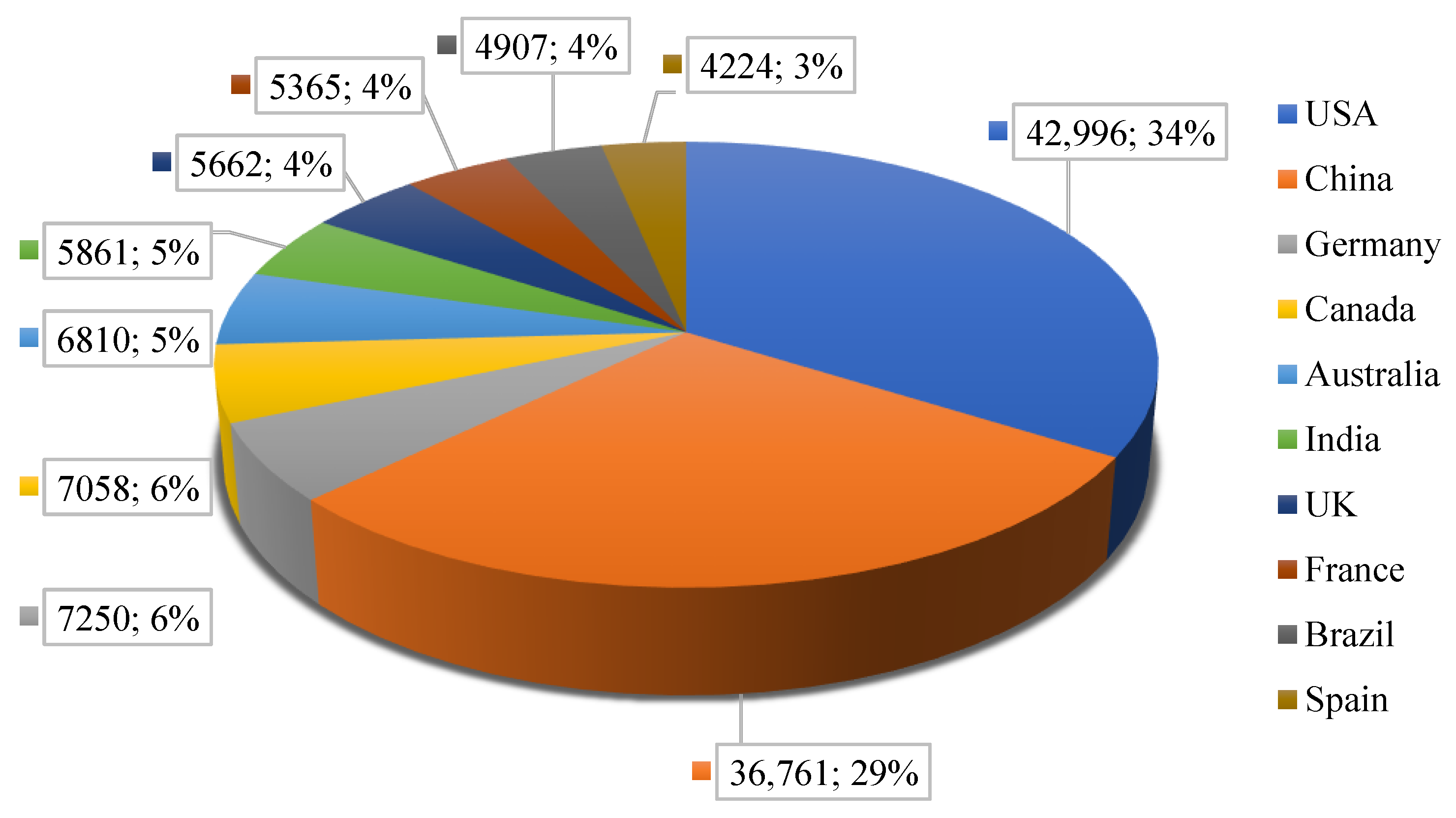
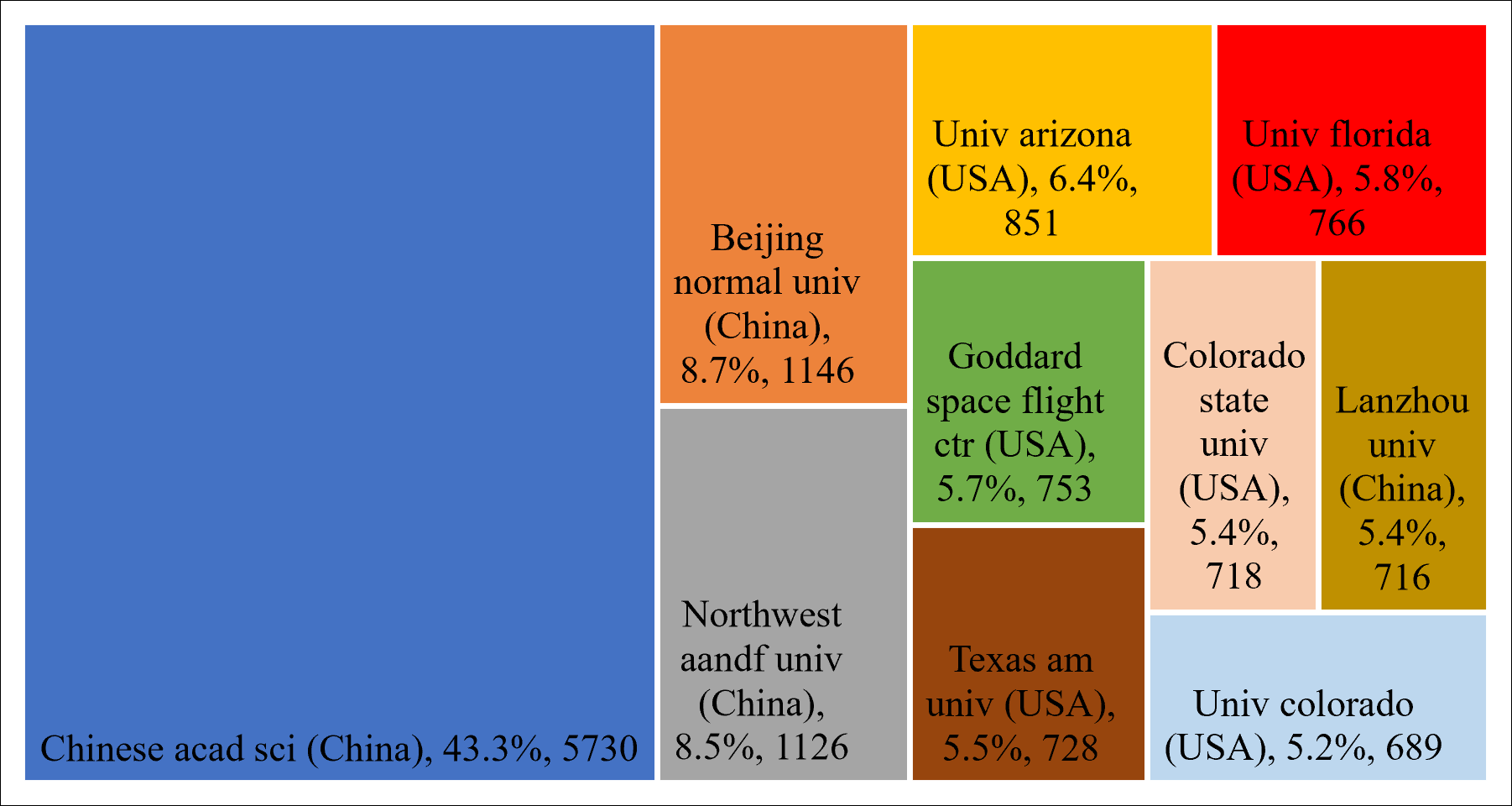

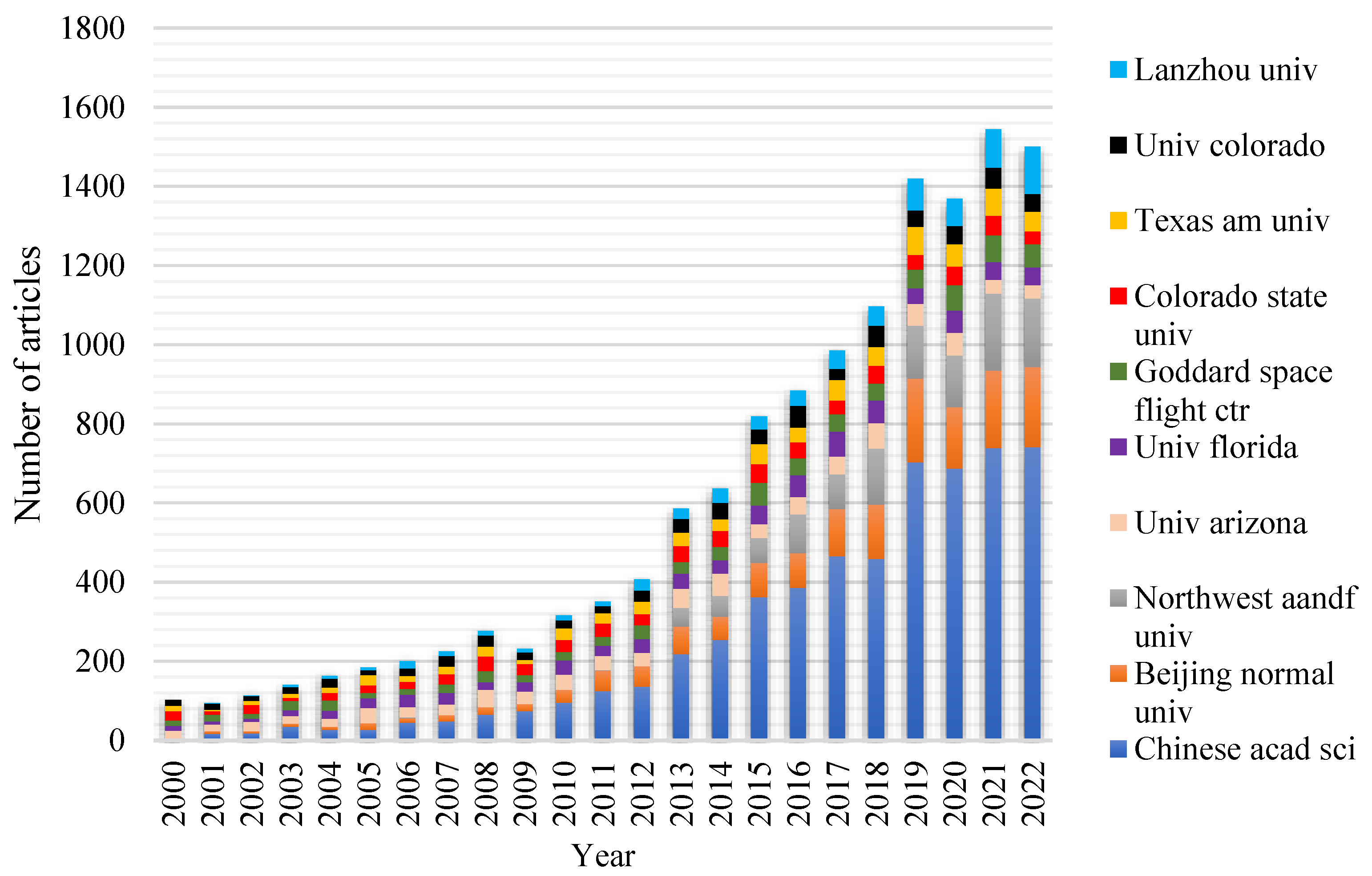
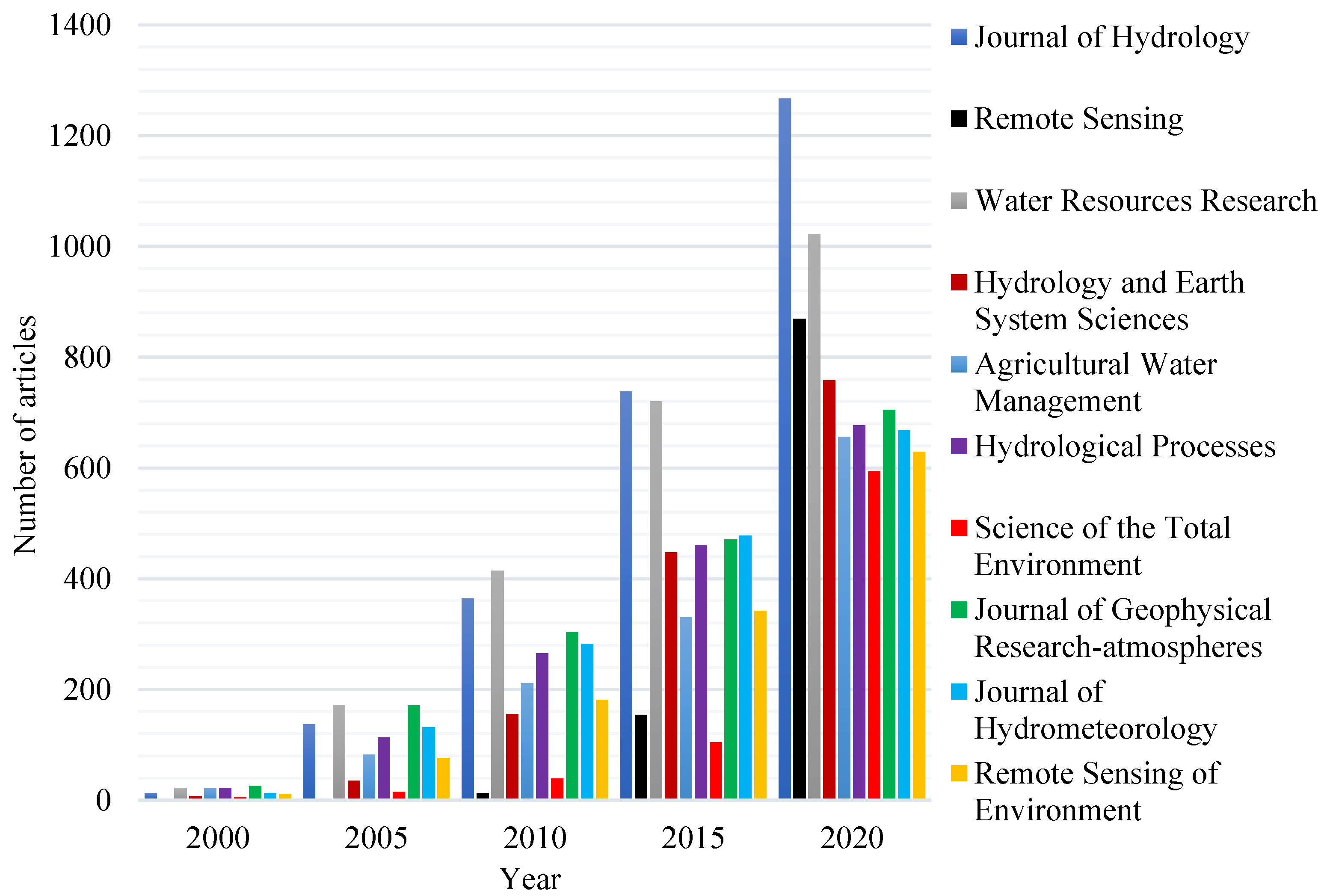

| Rank | Sources | TA | TC | IF | Quartile | H-Index |
|---|---|---|---|---|---|---|
| 1 | Journal of Hydrology | 1558 | 56,998 | 6.4 | Q1 | 104 |
| 2 | Remote Sensing | 1370 | 18,222 | 5.0 | Q1 | 56 |
| 3 | Water Resources Research | 1133 | 56,164 | 5.4 | Q1 | 112 |
| 4 | Science of the Total Environment | 899 | 17,251 | 9.8 | Q1 | 57 |
| 5 | Hydrology and Earth System Sciences | 880 | 33,500 | 6.3 | Q1 | 87 |
| 6 | Agricultural Water Management | 878 | 21,835 | 6.7 | Q1 | 67 |
| 7 | Hydrological Processes | 784 | 22,174 | 3.2 | Q2 | 69 |
| 8 | Journal of Geophysical Research—Atmospheres | 776 | 40,475 | 4.4 | Q1 | 91 |
| 9 | Journal of Hydrometeorology | 751 | 35,197 | 3.8 | Q2 | 93 |
| 10 | Remote Sensing of the Environment | 736 | 45,218 | 13.5 | Q1 | 103 |
| Rank | Keywords | Frequency | Rank | Keywords | Frequency |
|---|---|---|---|---|---|
| 1 | Climate change | 2050 | 11 | Biomass | 671 |
| 2 | Evapotranspiration | 1801 | 12 | Soil organic matter | 572 |
| 3 | Drought | 1655 | 13 | Nitrogen | 513 |
| 4 | Remote sensing | 1446 | 14 | Water use efficiency | 490 |
| 5 | Precipitation | 994 | 15 | Data assimilation | 478 |
| 6 | Soil temperature | 872 | 16 | Yield | 449 |
| 7 | Soil respiration | 731 | 17 | Vegetation | 432 |
| 8 | Temperature | 725 | 18 | Nitrous oxide | 423 |
| 9 | Soil properties | 707 | 19 | Hydrology | 419 |
| 10 | Irrigation | 685 | 20 | Water stress | 410 |
Disclaimer/Publisher’s Note: The statements, opinions and data contained in all publications are solely those of the individual author(s) and contributor(s) and not of MDPI and/or the editor(s). MDPI and/or the editor(s) disclaim responsibility for any injury to people or property resulting from any ideas, methods, instructions or products referred to in the content. |
© 2023 by the authors. Licensee MDPI, Basel, Switzerland. This article is an open access article distributed under the terms and conditions of the Creative Commons Attribution (CC BY) license (https://creativecommons.org/licenses/by/4.0/).
Share and Cite
Cai, Y.; Yang, Y.; Yue, X.; Xu, Y. Analysis of Hotspots and Trends in Soil Moisture Research since the 21st Century. Atmosphere 2023, 14, 1494. https://doi.org/10.3390/atmos14101494
Cai Y, Yang Y, Yue X, Xu Y. Analysis of Hotspots and Trends in Soil Moisture Research since the 21st Century. Atmosphere. 2023; 14(10):1494. https://doi.org/10.3390/atmos14101494
Chicago/Turabian StyleCai, Yuanxiang, Yaping Yang, Xiafang Yue, and Yang Xu. 2023. "Analysis of Hotspots and Trends in Soil Moisture Research since the 21st Century" Atmosphere 14, no. 10: 1494. https://doi.org/10.3390/atmos14101494
APA StyleCai, Y., Yang, Y., Yue, X., & Xu, Y. (2023). Analysis of Hotspots and Trends in Soil Moisture Research since the 21st Century. Atmosphere, 14(10), 1494. https://doi.org/10.3390/atmos14101494





